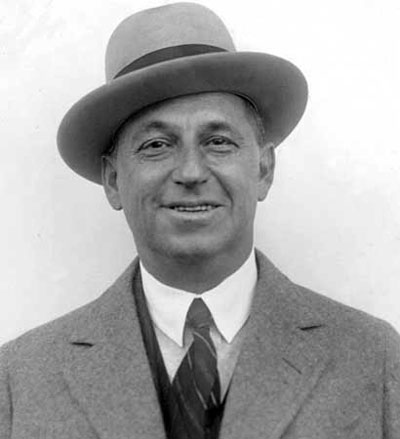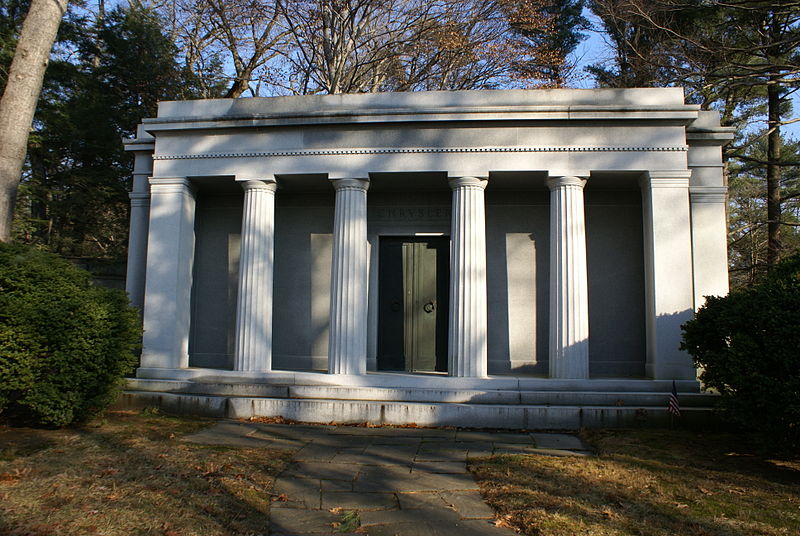<Back to Index>
- Machinist and Entrepreneur Walter Percy Chrysler, 1875
- Painter William Holman Hunt, 1827
- Emperor of the Byzantine Empire Andronikos IV Palaiologos, 1348
PAGE SPONSOR


Walter Percy Chrysler (April 2, 1875 – August 18, 1940) was an American machinist, railroad mechanic and manager, automotive industry executive, Freemason, and founder of the Chrysler Corporation.
He was born in Wamego, Kansas, and grew up in Ellis, Kansas. Chrysler apprenticed in the railroad shops at Ellis as a machinist and railroad mechanic. He then spent a period of years roaming the west, working for various railroads as a round house mechanic with a reputation of being good at valve - setting jobs. Some of his moves were due to restlessness and a too - quick temper, but his roaming was also a way to become more well rounded in his railroad knowledge. He worked his way up through positions such as foreman, superintendent, division master mechanic, and general master mechanic.
From 1905 - 1906, Chrysler worked for the Fort Worth and Denver Railway in Childress, a West Texas city considered the "Gateway to the Texas Panhandle." He later lived and worked in Oelwein, Iowa, where there is a small park dedicated to him. The pinnacle of his railroading career came at Pittsburgh, Pennsylvania, where he became works manager of the Allegheny locomotive erecting shops of the American Locomotive Company (ALCO). Chrysler's automotive career began in 1911 when he received a summons to meet with James J. Storrow, a banker who was a director of ALCO and also an executive at General Motors.
Storrow asked him if he had given any thought to automobile
manufacture. Chrysler had been an auto enthusiast for over 5 years by
then, and was very interested. Storrow arranged a meeting with Charles W. Nash, then president of the Buick Motor Company,
who was looking for a smart production chief. Chrysler, who had
resigned from many railroading jobs over the years, made his final
resignation from railroading to become works manager (in charge of production) at Buick in Flint, Michigan. He
found many ways to reduce the costs of production, such as putting an
end to finishing automobile undercarriages with the same luxurious
quality of finish that the body warranted. In 1916, William C. Durant, who founded General Motors in
1908, had retaken GM from bankers who had taken over the company.
Chrysler, who was closely tied to the bankers, submitted his
resignation to Durant, then based in New York City. Durant
took the first train to Flint to make an attempt to keep Chrysler at
the helm of Buick. Durant made the then unheard of salary offer of
US$10,000 (US$ 165,000 in today's dollars) a month for 3 years, with a
US$500,000 bonus at the end of each year, or US$ 500,000 in stock.
Additionally, Chrysler would report directly to Durant, and would have
full run of Buick without interference from anyone. Apparently in
shock, Chrysler asked Durant to repeat the offer, which he did.
Chrysler immediately accepted. Chrysler
ran Buick successfully for several more years. Not long after his three
year contract was up, he resigned from his job as president of Buick in
1919. He did not agree with Durant's vision for the future of General
Motors. Durant paid Chrysler US$10 million for his GM stock. Chrysler
had started at Buick in 1911 for US$ 6,000 a year, and left one of the
richest men in America. Chrysler was then hired to attempt a turnaround by bankers who foresaw the loss of their investment in Willys - Overland Motor Company in Toledo, Ohio.
He demanded, and got, a salary of US$ 1 million a year for 2 years, an
astonishing amount at that time. When Chrysler left Willys in 1921
after an unsuccessful attempt to wrest control from John Willys, he acquired a controlling interest in the ailing Maxwell Motor Company. Chrysler phased out Maxwell and absorbed it into his new firm, the Chrysler Corporation, in 1925. In addition to his namesake car company, Plymouth and DeSoto marques were created, and in 1928 Chrysler purchased Dodge. The same year he financed the construction of the Chrysler Building in New York City, which was completed in 1930. In 1929, Chrysler was named Time Magazine's Man of the Year.
In 1923, Chrysler purchased a twelve acre waterfront estate at
Kings Point on Long Island, New York from Henri Willis Bendel and
renamed it "Forker House." In December 1941, the property was sold to
the U.S. government's War Shipping Department and became known as Wiley
Hall as part of the United States Merchant Marine Academy. He also built a country estate in Warrenton, Virginia, in what is referred to as the Virginia horse country and home to the Warrenton Hunt.
In 1934, he purchased and undertook a major restoration of the famous
Fauquier White Sulphur Springs Company resort and spa in Warrenton.
Sold in 1953, the property was developed as a country club, which it
remains today. On the estate he inherited, Walter P. Chrysler, Jr. established North Wales Stud for the purpose of breeding Thoroughbred horses. Chrysler, Jr. was part of a syndicate that included friend Alfred G. Vanderbilt II who in 1940 acquired the 1935 English Triple Crown winner Bahram from the Aga Khan III. Bahram stood at stud at Vanderbilt's Sagamore Farm in Maryland then was brought to Chrysler's North Wales Stud. By 1936, Chrysler had handed off the running of his corporation to others, and saw himself more as a semi - retired patriarch. Walter Chrysler suffered a stroke in 1938 and died in 1940 at Forker House. He was buried at Sleepy Hollow Cemetery in Sleepy Hollow, New York. Walter Chrysler's father, Henry (Hank) Chrysler, was a Canadian - American of German and Dutch ancestry. He was an American Civil War veteran who was a locomotive engineer for the Kansas Pacific Railway and its successor, the Union Pacific Railroad. Walter's mother was born in Rocheport, Missouri, and was also of German ancestry. Walter
Chrysler was not especially interested in his remote ancestors; his
collaborative author Boyden Sparkes says that one genealogical
researcher reported "that he had a sea - going Dutchman among his
forebears; one Captain Jan Gerritsen Van Dalsen", but that "as to that,
Walter Chrysler made it plain to me he was in accord with Jimmy Durante: 'Ancestors? I got millions of 'em!'." However,
he thought enough of genealogy to include in his autobiography that his
father, Hank Chrysler, "Canadian born, had been brought from Chatham, Ontario, to Kansas City when he was only five or six. His forebears had founded Chatham; the family stock was German; eight generations back of me there had come to America one who spelled his name Greisler, a German Palatine. He was one of a group of Protestants who had left their German homeland in the Rhine Valley, gone to the Netherlands, thence to England and embarked, finally, from Plymouth for New York." Other researchers have since traced his ancestors in more detail. Karin Holl's monograph on the subject traces
the family tree to a Johann Philipp Kreissler, born in 1672, who left
Germany for America in 1709. Chrysler's ancestors came from the Rhineland - Palatinate town of Guntersblum.